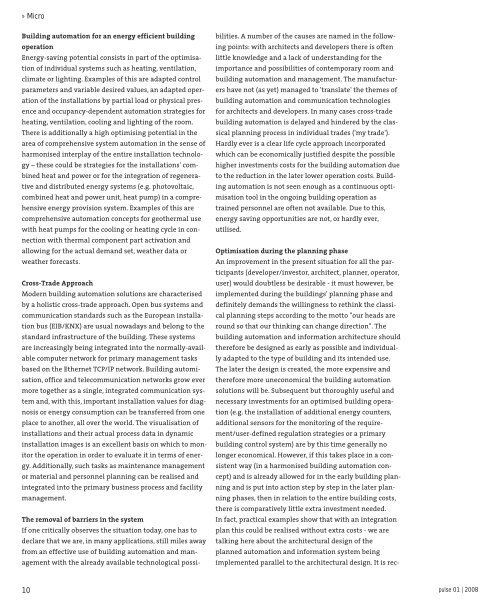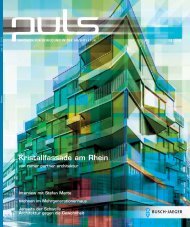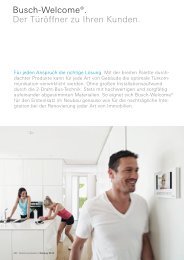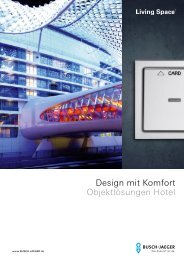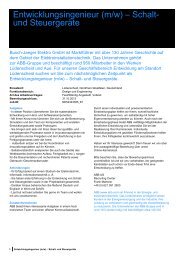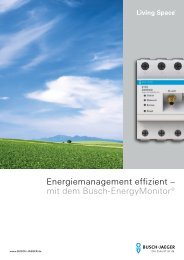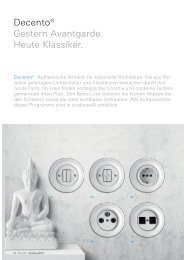The Ultimate Tower – Burj Dubai - Busch-Jaeger Elektro GmbH
The Ultimate Tower – Burj Dubai - Busch-Jaeger Elektro GmbH
The Ultimate Tower – Burj Dubai - Busch-Jaeger Elektro GmbH
Create successful ePaper yourself
Turn your PDF publications into a flip-book with our unique Google optimized e-Paper software.
» Micro<br />
Building automation for an energy efficient building<br />
operation<br />
Energy-saving potential consists in part of the optimisation<br />
of individual systems such as heating, ventilation,<br />
climate or lighting. Examples of this are adapted control<br />
parameters and variable desired values, an adapted operation<br />
of the installations by partial load or physical presence<br />
and occupancy-dependent automation strategies for<br />
heating, ventilation, cooling and lighting of the room.<br />
<strong>The</strong>re is additionally a high optimising potential in the<br />
area of comprehensive system automation in the sense of<br />
harmonised interplay of the entire installation technology<br />
<strong>–</strong> these could be strategies for the installations' combined<br />
heat and power or for the integration of regenerative<br />
and distributed energy systems (e.g. photovoltaic,<br />
combined heat and power unit, heat pump) in a comprehensive<br />
energy provision system. Examples of this are<br />
comprehensive automation concepts for geothermal use<br />
with heat pumps for the cooling or heating cycle in connection<br />
with thermal component part activation and<br />
allowing for the actual demand set, weather data or<br />
weather forecasts.<br />
Cross-Trade Approach<br />
Modern building automation solutions are characterised<br />
by a holistic cross-trade approach. Open bus systems and<br />
communication standards such as the European installation<br />
bus (EIB/KNX) are usual nowadays and belong to the<br />
standard infrastructure of the building. <strong>The</strong>se systems<br />
are increasingly being integrated into the normally-available<br />
computer network for primary management tasks<br />
based on the Ethernet TCP/IP network. Building automisation,<br />
office and telecommunication networks grow ever<br />
more together as a single, integrated communication system<br />
and, with this, important installation values for diagnosis<br />
or energy consumption can be transferred from one<br />
place to another, all over the world. <strong>The</strong> visualisation of<br />
installations and their actual process data in dynamic<br />
installation images is an excellent basis on which to monitor<br />
the operation in order to evaluate it in terms of energy.<br />
Additionally, such tasks as maintenance management<br />
or material and personnel planning can be realised and<br />
integrated into the primary business process and facility<br />
management.<br />
<strong>The</strong> removal of barriers in the system<br />
If one critically observes the situation today, one has to<br />
declare that we are, in many applications, still miles away<br />
from an effective use of building automation and management<br />
with the already available technological possi-<br />
10<br />
bilities. A number of the causes are named in the following<br />
points: with architects and developers there is often<br />
little knowledge and a lack of understanding for the<br />
importance and possibilities of contemporary room and<br />
building automation and management. <strong>The</strong> manufacturers<br />
have not (as yet) managed to 'translate' the themes of<br />
building automation and communication technologies<br />
for architects and developers. In many cases cross-trade<br />
building automation is delayed and hindered by the classical<br />
planning process in individual trades ('my trade').<br />
Hardly ever is a clear life cycle approach incorporated<br />
which can be economically justified despite the possible<br />
higher investments costs for the building automation due<br />
to the reduction in the later lower operation costs. Building<br />
automation is not seen enough as a continuous optimisation<br />
tool in the ongoing building operation as<br />
trained personnel are often not available. Due to this,<br />
energy saving opportunities are not, or hardly ever,<br />
utilised.<br />
Optimisation during the planning phase<br />
An improvement in the present situation for all the participants<br />
(developer/investor, architect, planner, operator,<br />
user) would doubtless be desirable - it must however, be<br />
implemented during the buildings' planning phase and<br />
definitely demands the willingness to rethink the classical<br />
planning steps according to the motto "our heads are<br />
round so that our thinking can change direction". <strong>The</strong><br />
building automation and information architecture should<br />
therefore be designed as early as possible and individually<br />
adapted to the type of building and its intended use.<br />
<strong>The</strong> later the design is created, the more expensive and<br />
therefore more uneconomical the building automation<br />
solutions will be. Subsequent but thoroughly useful and<br />
necessary investments for an optimised building operation<br />
(e.g. the installation of additional energy counters,<br />
additional sensors for the monitoring of the requirement/user-defined<br />
regulation strategies or a primary<br />
building control system) are by this time generally no<br />
longer economical. However, if this takes place in a consistent<br />
way (in a harmonised building automation concept)<br />
and is already allowed for in the early building planning<br />
and is put into action step by step in the later planning<br />
phases, then in relation to the entire building costs,<br />
there is comparatively little extra investment needed.<br />
In fact, practical examples show that with an integration<br />
plan this could be realised without extra costs - we are<br />
talking here about the architectural design of the<br />
planned automation and information system being<br />
implemented parallel to the architectural design. It is rec-<br />
pulse 01 | 2008


